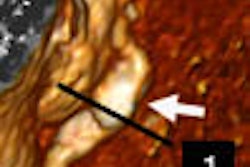Coronary plaque types and distribution patterns seen with CT angiography (CTA) may predict clinically significant coronary artery disease, according to a study from Weill Medical College of Cornell University in New York City.
"Not only is the extent of plaque important but the type of plaque as well," said lead author Dr. James Min in a presentation at the 2006 American College of Cardiology (ACC) meeting in Atlanta. Min is the director of cardiac CT at the university.
The researchers evaluated 133 consecutive patients who had been referred for both coronary CTA and invasive coronary angiography (ICA). Major epicardial arteries were examined for plaque type (soft, mixed, or calcified), plaque focality (focal or diffuse), and plaque extent (none, mild, moderate, and severe). ICA and coronary CTA results were independently reviewed.
Patients with clinically significant coronary artery disease (CS-CAD) had significantly more mixed plaque (less than 75% either calcified or soft) -- 75.7% compared to 45.7% in patients without CS-CAD. The prevalence of other plaque types was similar between the groups.
Plaque in more than three discrete sites or covering more than a third of the vessel was also significantly more common in patients with CS-CAD -- 77.6% versus 35.6%.
Severe plaque blocking more than half of the vessel and moderate plaque causing stenosis of a quarter to a half of the vessel were similarly much more common in patients with CS-CAD. About 90% of CS-CAD patients had severe plaque and 76.3% had moderate plaque, while only 37.6% of patients with less significant heart disease had severe plaque and 19.6% had moderate plaque levels.
Those with both mixed and diffused plaque had high rates of CS-CAD -- 91.7% compared to 33.3% without both categories of plaque. Mixed plaque and diffuse plaque were both independent predictors of clinically significant CAD in a multivariate analysis.
Although not many groups nationwide are doing plaque type and extent evaluations, the technology is already available and the Cornell group commonly uses it.
"It is already our current reading style," said co-author Dr. Jonathan Weinsaft, director of the cardiac MR program at Cornell. "It currently affects the way we treat patients."
However, the clinical relevance of plaque types and distribution seen with coronary CTA has not been well-studied. "The next obvious step is to look at plaque types and relate them to outcomes," Min said.
By Crystal Phend
AuntMinnie.com contributing writer
May 8, 2006
Related Reading
CTA proves faster and cheaper for assessing chest pain in ER, April 11, 2006
CTA finds heart disease when calcium score is unreliable, April 5, 2006
Copyright © 2006 AuntMinnie.com



















